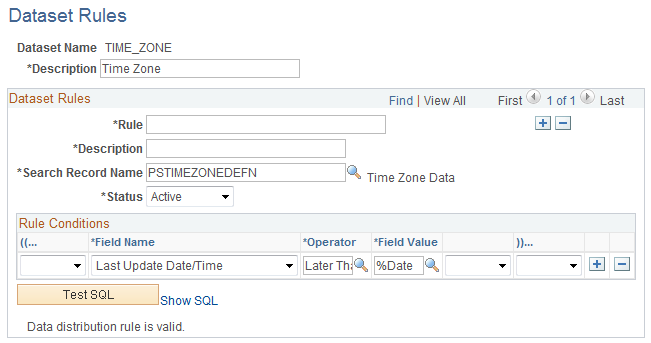Defining Dataset Rules
This section provides an overview of dataset rules and discusses how to create dataset rules.
|
Page Name |
Definition Name |
Usage |
|---|---|---|
|
EOEC_DATASET |
Define the rules that make up a dataset. |
Dataset rules define datasets for use in conjunction with each dataset role’s security rules. Defining dataset rules creates Structured Query Language (SQL) statements that select the dataset displayed for each rule.
To use dataset rules and roles:
Define dataset rules, which are based on a synchronized record.
You define a dataset rule to return a subset of rows from the selected synchronized record based on the dataset role to which you will link the rule.
These dataset rules are based on views that can join to any record in your PeopleSoft system.
For each rule condition, the user specifies a field that comes from the search record name defined in the dataset rule. When the specified field has neither a prompt or translate table edit, the following system variables, which are delivered as system data to all applications, can be used to filter the condition:
%Blank
%Date
%EmployeeID
%PersonID
%Time
%UserID
Assign the dataset rules to dataset roles, according to role security and data requirements.
Each dataset role can have multiple dataset rules. You can use existing dataset roles, or create new dataset roles by selecting from existing PeopleTools security-based user roles.
See PeopleTools: Security Administration, “Understanding Roles”.
Ensure that the original user roles on which dataset roles were based are associated with appropriate user IDs.
Each user ID can have multiple user roles.
See PeopleTools: Security Administration, “User Profiles - Roles Page”
Use the Dataset Rules page (EOEC_DATASET) to define the rules that make up a dataset.
Navigation:
This example illustrates the fields and controls on the Dataset Rules page. You can find definitions for the fields and controls later on this page.

The number of rule conditions in a dataset rule is limited only by your performance requirements. You can set a series of rule conditions that can navigate through as many records as necessary.
Dataset Rules
Field or Control |
Description |
|---|---|
Search Record Name |
Select the name of the search record for this rule. You can create a view specifically for use in the rule. |
Status |
Select Active or Inactive. |
Rule Conditions
Field or Control |
Description |
|---|---|
…(( and ))… |
If the AND or OR field is left blank, specify the nesting level for this condition. Be sure to match opening and closing parentheses. |
Field Name |
Select the field name on which this rule operates. |
Operator |
Specify the operation with which to compare the specified field value. Select from standard conditional operators. |
Field Value |
Specify the value of the specified field against which to compare. |
AND or OR |
For second and subsequent rule conditions, specify AND or OR, or leave blank if the rule statements are nested. |
Test SQL |
Click to test the validity of the rule conditions. The result is returned below the button. |
Show SQL |
Click to view the SQL statement generated by the rule. |